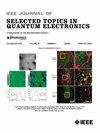锡含量高达 8.4% 的 GeSn 薄膜随温度变化的介电响应、折射率和吸收系数
IF 4.3
2区 工程技术
Q1 ENGINEERING, ELECTRICAL & ELECTRONIC
IEEE Journal of Selected Topics in Quantum Electronics
Pub Date : 2024-10-24
DOI:10.1109/JSTQE.2024.3486025
引用次数: 0
摘要
采用椭圆偏振光谱法测量了三种Ge(1-x)Snx薄膜的光学性质。薄膜的Sn含量分别为3.6%、6.5%和8.4%,且均完全应变到Ge(001)衬底上。在78 ~ 475 K温度范围内,光学常数在0.39 ~ 4.116 eV范围内。随着Sn含量的增加和温度的升高,能带结构中的临界点能量发生了红移。在GeSn样品的E0+Δ和E1跃迁之间出现了一个额外的临界点,而在Ge样品中没有出现。本文章由计算机程序翻译,如有差异,请以英文原文为准。
Temperature-Dependent Dielectric Response, Index of Refraction, and Absorption Coefficient of GeSn Films up to 8.4% Sn
Three Ge
(1-x)
Sn
x
films were measured by spectroscopic ellipsometry to extract their optical properties. The Sn contents of the films were 3.6%, 6.5%, and 8.4%, and all were fully strained to a Ge (001) substrate. Optical constants were collected from 0.39–4.116 eV, at temperatures between 78 K and 475 K. Critical point energies in the band structure were red-shifted with increasing Sn content and increasing temperatures. An extra critical point appears between E
0
+Δ and E
1
transitions in GeSn samples that does not appear in Ge.
求助全文
通过发布文献求助,成功后即可免费获取论文全文。
去求助
来源期刊

IEEE Journal of Selected Topics in Quantum Electronics
工程技术-工程:电子与电气
CiteScore
10.60
自引率
2.00%
发文量
212
审稿时长
3 months
期刊介绍:
Papers published in the IEEE Journal of Selected Topics in Quantum Electronics fall within the broad field of science and technology of quantum electronics of a device, subsystem, or system-oriented nature. Each issue is devoted to a specific topic within this broad spectrum. Announcements of the topical areas planned for future issues, along with deadlines for receipt of manuscripts, are published in this Journal and in the IEEE Journal of Quantum Electronics. Generally, the scope of manuscripts appropriate to this Journal is the same as that for the IEEE Journal of Quantum Electronics. Manuscripts are published that report original theoretical and/or experimental research results that advance the scientific and technological base of quantum electronics devices, systems, or applications. The Journal is dedicated toward publishing research results that advance the state of the art or add to the understanding of the generation, amplification, modulation, detection, waveguiding, or propagation characteristics of coherent electromagnetic radiation having sub-millimeter and shorter wavelengths. In order to be suitable for publication in this Journal, the content of manuscripts concerned with subject-related research must have a potential impact on advancing the technological base of quantum electronic devices, systems, and/or applications. Potential authors of subject-related research have the responsibility of pointing out this potential impact. System-oriented manuscripts must be concerned with systems that perform a function previously unavailable or that outperform previously established systems that did not use quantum electronic components or concepts. Tutorial and review papers are by invitation only.
 求助内容:
求助内容: 应助结果提醒方式:
应助结果提醒方式:


